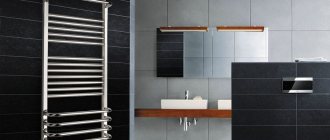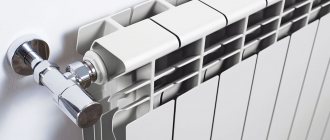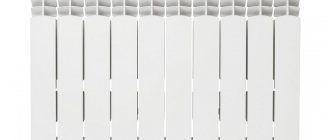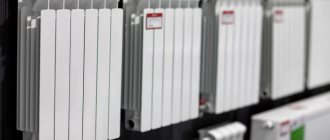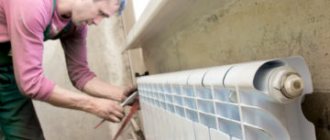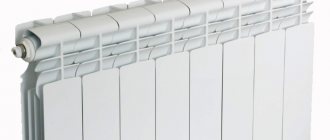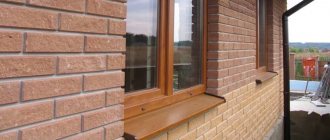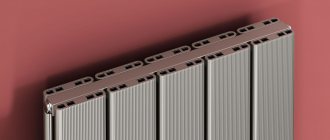Low heating radiators are found in any group of heating devices. This category includes equipment whose height does not exceed 45 cm. Such small batteries are usually sought for aesthetic reasons: with panoramic glazing or low window sills. Sometimes you need to heat an entire cold wall, in which case this is one of the most effective options. After all, low radiators have low heat transfer, which means their length will be significant, which is what is needed to heat a cold or “wet” wall.
It is clear that you want everything to look stylish, but in heating you cannot focus only on aesthetics: technical data are also very important. That’s why they pay attention to the metal from which they are made. After all, it is its properties that largely determine the characteristics of radiators and their scope of application.
Non-standard radiator sizes
In addition to standard heating devices, radiators of other sizes are widely available on the market.
They are intended for use in atypical buildings or to give a room a special style. The following types and dimensions of radiators are distinguished:
Low or small heating radiators have a high heat transfer per unit surface area; they can be placed under low window sills or in buildings with stained glass. These include all heating devices with a center distance of less than 400 mm. Based on the material used, they can be either cast iron, aluminum or bimetallic.
Low horizontal cast iron heating radiators predominantly have section dimensions (W x D x H) of 93 x 140 x 388 mm, their heat output is 106 W at an operating pressure of 9 atm. Foreign manufacturers also produce more compact models with center distances of 200 and 350 mm. Bimetallic compact heating devices are available with a wide range of center distances, the width of such a section starts from 40 mm, the height is in the range of 150-450 mm. The depth compensates for the compactness of the remaining dimensions and is 180 mm. Thermal power varies from 80 to 140 watts at an operating pressure of 25-35 atmospheres.
Aluminum radiators have dimensions similar to bimetallic ones with connection distances from 150 to 400 mm in 500 mm increments, thermal power ranges from 50 to 160 W.
The normal operating pressure for them is 16 atmospheres, which can be increased to 24 atmospheres during pressure testing. It should be noted that such narrow horizontal bimetallic and aluminum heating radiators do not have water flow through the middle sections; they are heated only due to thermal conductivity from the collectors, while circulation is ensured by the outer flow section.
There are tall and narrow heating radiators, which are used in cases where there is a need for high heat transfer when, for various reasons, it is impossible to occupy a significant length of the wall. Cast iron high heating radiators are found only among products of foreign manufacturers; their section width is 76 mm. with a possible height of 661-954 mm, the depth of such devices reaches 203 mm. The working pressure is 10 atmospheres, and for the largest ones it cannot exceed 6 atmospheres. heat transfer, depending on the size, ranges from 270 to 433 watts.
Narrow bimetallic heating radiators are mainly designer designs with non-standard dimensions and are not intended for central heating systems; they are used in private houses with individual heating. As a rule, these are not sectional, but monolithic structures. If we take a section, then an example of its size could be (W x D x H) 80 x 95 x 880 mm. at a working pressure of 4 atmospheres. When crimping, it is not recommended to exceed this figure more than 6 atm.
For those who want to make the most efficient use of room space, flat heating radiators with a shallower depth are available on the market. Their choice is not as large as that of the above heating devices. Sold thin heating radiators can only be made of aluminum. Their depth starts from 52 mm with thermal power from 105 to 161 W. Flat radiators also include panel radiators, the depth of which is 60 mm.
Steel tubular
This category has the largest range of low radiators. And the low ones here are:
- from 150 mm height for Purmo - Delta Laserline model;
- from 180 mm, Arbonia has almost all models of the “standard” range, there is also a radiator-bench, with a height of 180 mm;
- from 190 mm for Zehnder, Charleston model and bench radiators from 400 mm and 410 mm.
- With an axle distance of 300 mm from the Russian KZTO.
Tubular radiators are very decorative
At any manufacturer of tubular radiators you will find those that can be classified as low. They can have from two to six columns of pipes, respectively, they will have different depths - from 50 mm to 250 mm. Each of the models can be installed on the floor or hung on the wall (specify when ordering).
Advantages and disadvantages
Tubular radiators can have a nonlinear shape.
The advantages include a large selection of models, with different widths and depths, ease of cleaning, attractive appearance, and a large number of decorative options. The large cross-section of the pipes creates little hydraulic resistance, and such radiators rarely become clogged.
Disadvantages are caused by steel: susceptibility to corrosion, high requirements for coolant, low operating pressure, short service life - from 5 to 10 years. Exception: Zehnder Charleston Pro
, which is internally treated with two compounds. They resist corrosion so well that this option can stand at Ph 5-11. The warranty period is 25 years.
Application area
Basically, tubular radiators are designed for individual heating. Moreover, they can work both in systems with forced and natural gravity. The only requirement is that the system must be closed.
Dimensions of standard radiators
Depending on the material from which the radiators are made, their dimensions also differ. The most common standard sizes of heating devices are considered as basic, refer to the center distance of 500 mm and are:
- The standard dimensions of cast iron heating radiators according to the specification are for one section (width x depth x height) 93 x 140 x 588 mm. In various modifications, the depth can also be 85, 90 and 110 mm, and the width – 108 mm. For exotic cast iron radiators in “retro” style, the standard sizes are even more varied. It is not difficult to determine the dimensions of the heating device assembled from them - 10 mm of the thickness of the paronite gasket is added to each section. Also, if the radiator is installed in a niche or in cramped conditions, you should take into account the length of the mandatory installed flush valve. The heat output of one section is about 160 W. with a difference in room air temperature and coolant temperature of 70 C, the maximum permissible operating pressure in the system is 9 atmospheres.
- The standard dimensions of bimetallic heating radiators (width x depth x height), due to the wide range and significant number of manufacturers, are as follows: 80-82 x 75-100 x 550-580 mm. The average heat flow from a section of such a device is about 160-200 W; due to the presence of a steel core in the design, the operating pressure in the system can reach 25-30 atm. and during pressure testing, pressure testing up to 35-50 atmospheres is possible.
- Aluminum horizontal heating radiators, even with the same dimensions, can differ significantly in technical parameters. The standard dimensions of their sections are (W x D x H) 80 x 80-100 x 575-585 mm. The heat transfer of a section of this type of heating device depends on the fins and the depth of the structure, being in the range of 180-200 watts at a maximum operating pressure of the system of 16 atmospheres. Such radiators are pressurized under pressure up to 24 atm.
ATTENTION! When installing a heating system, an important condition is to use pipes of equal strength to the radiators, otherwise emergency situations may be created.
Baseboard heating
This type of heating devices appeared in our country not so long ago. These are devices very similar to copper-aluminum radiators: the same copper tube on which copper or aluminum convective plates are placed. They just have a different connection method, layout and different dimensions. Heating elements can be inserted into heating modules (tubes with plates) or they can be assembled into closed circuits through which the coolant circulates. They are located along the floor along the perimeter of the walls, covered with metal decorative overlays. The width is about 3 cm, the height is 12-20 cm, depending on the power. Exactly low radiators.
This is what baseboard heating looks like. No more other heating devices
Advantages, disadvantages
The advantage is that most of the heat (70-80%) is transferred by thermal radiation. The heat rising from warm baseboards heats up the walls first. They then begin to radiate heat. Therefore, a more uniform temperature is observed in the room, and warm air does not accumulate at the top.
Another plus is its very compact size and quite high heat output: one meter produces 180-280 W at average temperatures. In addition, they are not conspicuous and provide wide scope for design solutions.
The only downside is the high price.
Application area
Excellent in individual heating systems. It is possible to install electric heated skirting boards in apartments. Connecting to central heating requires a complex system: for optimal operation, the difference between the supply and return pipelines should not exceed 5oC, therefore each circuit should be no more than 12-14 meters long, and a mixing unit must be installed to maintain normal temperature.
Heating devices of single-pipe systems
An important feature of the horizontal “Leningrad” is the gradual decrease in temperature in the main line due to the admixture of coolant cooled by the batteries. If 1 ring line serves more than 5 devices, the difference at the beginning and end of the distribution pipe can reach 15 °C. The result is that the latest radiators emit less heat.
Single-pipe closed circuit - all heaters are connected to 1 pipe
To ensure that long-distance batteries transfer the required amount of energy to the room, make the following adjustments when calculating heating power:
- Select the first 4 radiators according to the instructions above.
- Increase the power of the 5th device by 10%.
- Add another 10 percent to the calculated heat transfer of each subsequent battery.
Advantages and disadvantages of narrow radiators
Narrow radiators have good heat transfer
Narrow radiators have the following advantages:
- Suitable for universal use. Such structures can be installed near a wall, under a window or anywhere else in the room. Many of them have an aesthetic appearance.
- Good heat dissipation. This parameter corresponds to a greater extent to vertical radiators. They heat the air simultaneously in the upper and lower parts of the room.
- Good quality. Narrow radiators are reliable and tight. All joints are made with perfect, durable seams. The approximate service life of the radiator is 10-15 years.
- Suitable for heating rooms with non-standard shape and area. For the space under the stairs or the cellar, such a heater will be very useful, as it will easily fit into the room.
The disadvantage of these types of radiators is their high cost.
Disadvantages of this equipment:
- Installation under a window is not always possible. This is not only the most convenient area, but also quite functional. There is fairly effective air circulation here.
- High price. Instead of one narrow battery, you can buy two or three ordinary ones. It all depends on the size and power of each. However, narrow options heat the room better.
- The small radiator needs flushing. It is best to do this twice a year: before starting and turning off the heating. Some complex structures tend to become clogged, resulting in air pockets.
The efficiency of heating narrow heating radiators depends on the correct choice of the device and its advantages, as well as some installation features.
Classification of heating devices
Depending on the material used for manufacturing, heating radiators can be:
- steel;
- aluminum;
- bimetallic;
- cast iron
Each of these types of radiators has its own advantages and disadvantages, so it is necessary to study their technical characteristics in more detail.
Cast iron batteries - time-tested heating devices
The main advantages of these devices are high inertness and fairly good heat transfer. Cast iron batteries take a long time to heat up and are also able to release the accumulated heat for a long time. The heat output of cast iron radiators is 80-160 W per section.
These devices have many disadvantages, among which the most serious are:
- a large difference between the flow area of the risers and batteries, as a result of which the coolant moves slowly through the radiators, which leads to their rapid contamination;
- low resistance to water hammer, operating pressure 9 kg/cm2;
- heavy weight;
- requirement for regular care.
Aluminum radiators
Batteries made of aluminum alloys have a lot of advantages. They are attractive, do not require regular maintenance, and are not brittle, which makes them better resistant to water hammer than their cast iron counterparts. Working pressure varies depending on the model and can be from 12 to 16 kg/cm2. Another undeniable advantage of aluminum batteries is the flow area, which is less than or equal to the internal diameter of the risers. Thanks to this, the coolant moves inside the sections at high speed, which makes it almost impossible for dirt to accumulate inside the device.
Many people believe that a small cross-section of radiators leads to low heat transfer. This statement is incorrect, since the heat transfer of aluminum is higher than, for example, that of cast iron, and the small cross-section in the batteries is more than compensated by the area of the radiator fins. According to the table below, the heat output of aluminum radiators depends on the model and can range from 138 to 210 W.
But, despite all the advantages, most experts do not recommend them for installation in apartments, since aluminum batteries may not withstand sudden pressure surges when testing central heating. Another disadvantage of aluminum batteries is the rapid destruction of the material when other metals are used in conjunction with it. For example, connecting to radiator risers through brass or copper pipes can lead to oxidation of their inner surface.
Bimetallic heating devices
These batteries do not have the disadvantages of their cast iron and aluminum “competitors”. A design feature of such radiators is the presence of a steel core in the aluminum fins of the radiator. As a result of this “fusion”, the device can withstand colossal pressure of 16-100 kg/cm2.
The flow area of the device is, as a rule, smaller than that of risers, so bimetallic radiators are practically not contaminated.
Despite its many advantages, this product has a significant drawback - its high cost.
Steel radiators
Steel radiators are perfect for heating rooms powered by an autonomous heating system. However, such radiators are not the best choice for central heating as they may not withstand the pressure. They are quite light and resistant to corrosion, with high inertia and good heat transfer rates. Their flow area is most often smaller than that of standard risers, so they rarely become clogged.
Among the disadvantages are the rather low operating pressure of 6-8 kg/cm2 and resistance to water hammer, up to 13 kg/cm2. The heat transfer rate for steel batteries is 150 W per section.
The table shows the average heat transfer and operating pressure for heating radiators.
Steel panel
Steel panel radiators are low: they are usually made from 300 mm in height (here it is the height of the radiator, and not the interaxal distance). Any manufacturer has them: Russian Prado and European Purmo and Kermi.
There are also lower ones, but they are rare. So ]Purmo[/anchor] has models Ventil Compact, Purmo Planora and Ramo Compact. Their height starts from 200 mm (center distance 150 mm). We haven't found any others this small.
Steel panel radiators can be very low
Advantages and disadvantages
The advantages of steel radiators include their compact size and the lowest price per kilowatt of power. In addition, steel is a non-capricious metal that does not conflict with other components of the system.
The main disadvantage is the tendency to corrosion, and hence the demand for coolant: Ph 7-8 and lack of oxygen (closed systems). The panel walls have a thickness of 1.25 mm or 1.4 mm. If the coolant is of poor quality, they can be corroded within a few seasons. There is another disadvantage, which is due to the design: the small width of the channels through which the coolant circulates. If there is a large amount of contaminants in the coolant, they quickly become clogged. But flushing such a radiator is a problem. Another disadvantage is the difficulty of cleaning in the presence of plates with convective ribs.
Read more about steel radiators here.
Application area
Normally, panel radiators are installed in individual closed systems (with a closed expansion tank). Coolant circulation must be forced: these heating devices have high hydraulic resistance.
It is not recommended to install them in high-rise apartments; the pressure rarely allows this (working 10 bar). Only in systems that have their own water treatment (independent type of connection) with a mandatory deaeration stage (air removal).
Influence of aluminum radiator size
Aluminum batteries are made in a wide range of sizes. Length has a primary influence on power.
Accordingly, to achieve the required heating it is necessary to increase the number of sections. The total length of the battery depends on the calculations.
Depth and height also change the indicators because they affect volume. Unlike length, these two values are variable, which is why there are many different models.
The next indicator is the center distance. It is responsible for the heating rate of the radiators, since it means the gap between the supply and return pipes.
The performance is also affected by the manufacturing method:
Metal casting increases the strength and durability of the device. In this case, each section is a single unit from which the device is assembled. This is done in a certain sequence: first the upper parts are welded, then the lower ones. The extrusion method involves pressing heated aluminum through a lattice plate of metal. Thanks to this, a profile of a given shape is obtained, which is divided into parts and assembled into a radiator
Attention! Such heating devices are rarely found and are usually made to order. This is due to the impossibility of making changes to the design after production has ended.
Center distance
The indicator represents the gap between the axes of the radiator. They are located symmetrically, one on top, the other on the bottom. They are adjacent to pipes through which they are connected to the heating circuit.
Photo 1. Aluminum radiator model 350/80, center distance 350 mm, China.
Depending on the manufacturer, the value ranges from 150-2000 mm. For most devices, this figure is set to 500. This is due to heating systems in apartment buildings: in old buildings, calculations were made for cast iron radiators. When replacing batteries, the cost of digesting the pipeline is undesirable.
Reference! Most models have a number in their name indicating the center distance.
Depth
Depends on the material from which the battery is made. The minimum value is 52 mm. It is enough to create high power in small sections. The maximum value is 180 mm. It is quite rare and requires strength. There are models with greater depth, but their use is impractical due to insufficient heating.
Determining the volume of a section
To calculate, you need to know the value described above, as well as the length and height. The first value, visually, is width.
It is 80 or 88 mm, which is indicated in the passport.
The second is variable. Typically, the vertical component of the section dimensions is 570 mm.
To find the volume, just multiply the three indicators.
Bimetallic
Bimetallic radiators are usually called heating devices in which the collectors through which water flows are made of steel (sometimes stainless, sometimes black). An aluminum “jacket” of ribs is then fused onto this frame (to increase heat transfer).
Bimetallic radiators do not have very small radiators
Such batteries have a high operating pressure - up to 20-24 Bar, can work with almost any coolant (stainless steel manifolds work with any), and have a fairly high heat transfer. Their disadvantage: often a small cross-section of vertical ducts, as well as a high price.
The situation here is almost the same as in aluminum ones: some manufacturers have very small radiators with a height of 245-265 mm (the same Sira and Rifar have them), and almost all of them have a height from 350 mm to 450 mm.
Advantages, disadvantages
Advantages - high working pressure, compatibility with any metals (aluminum does not come into contact with the coolant or supply pipelines). Works with coolant in a wide range - Ph 6.5-9 in models with steel collectors and Ph from 5 to 10-11 in models with stainless steel (Royal Thermo, Calidor, Nova Florida, Radena). Another good quality is the high heat transfer of the section, as well as low inertia (allows you to accurately regulate the temperature in the room using an automatic boiler or a temperature regulator for the radiator).
Disadvantages: high price, which is due to the high complexity of the technology. And one more drawback: some companies make vertical collectors of small diameter, and if there is a high content of suspended particles in the coolant, they can become clogged. Therefore, it is advisable to install filters at the inlet (and they need to be cleaned regularly).
Application area
This type of radiator was developed specifically for the conditions of our central heating. That’s why they need to be installed in high-rise apartments. They will work great in individual heating, but why pay a lot of money for an unnecessary safety margin (almost tenfold)?
How to choose the correct size of radiator sections
Determining the dimensions of the sections and their number is the most important step in creating a classic heating system.
With standard arrangement
The power they can develop depends on the size of the batteries and the material.
The length is almost always the same and is 80 mm. First determine the height. To do this, choose the installation location, which determines the available space.
And design also plays a big role. Using these parameters, the vertical component is determined. Usually decide between 350 and 500 millimeters.
Depending on the characteristics of the room, you can purchase devices from 200 mm. If a radiator is purchased for a bathroom or toilet, we recommend a narrow model that can completely cover the space between the floor and ceiling. High-altitude devices have different variations from one and a half to three meters.
Having determined two linear characteristics and the material, we move on to calculating the depth and number of sections. The number of the latter is usually taken to be 10, but others also occur. The thickness is found from the volume. The cubic value is divided into length and height. The determination of power is also closely related to these indicators: knowing the required power, you can find the number of sections.
With original interior
To create a design, manufacturers often sacrifice technical characteristics.
First of all, this applies to cast iron products. Domestic radiators look serious, but are simply covered with paint.
European ones are more elegant, but weaker in heating. In any case, you need to find out from the documentation about the power that they are capable of developing, since you need to select devices based on heat transfer.
Reference! There are batteries in “retro” style. They have a pleasant appearance, but are expensive.
Aluminum ones have the same shape, with the exception of custom ones, but they differ in a variety of colors. In addition, a wide range of dimensions helps them fit into almost any area of the room.
Bimetallic radiators, unlike their analogues, are made not only straight, but also curved. This makes them look good in rooms with smooth angles.
Regardless of the material chosen, before purchasing you should read the technical documentation and find out the dimensions of the internal parts of the sections containing the coolant.
This will help you decide on the batteries not only by their external appearance, but also by their ability to heat.
You should remember the possibility of combinations. So, if a certain device suits the design, but its power is not enough, you can install additional heating by hiding it behind the side panel. Or combine radiator heating with warm floors.
A good option for guest rooms would be to install a fireplace. Although the latter more often serves a decorative role, it is also capable of reducing the number or size of sections installed in the room. Sometimes it's better to sacrifice beauty than to freeze every winter.
If you want to create a special design, you should contact the battery manufacturers. They will help you do the calculations. Thanks to this, the finished product will look beautiful and perform its direct function.
Results of choosing heating radiators for an apartment
If we approach it from a practical point of view, then for apartments with a central heating system we can recommend bimetallic radiators without any doubt. These batteries definitely won't let you down.
We exclude aluminum radiators immediately. What remains are steel and cast iron products, which can be used with some restrictions. Preferably in low-rise buildings and preferably with boiler houses that ensure smooth supply and shut-off of water.
We hope our article helped you make your choice and answer the question: “which heating radiators are best to install in an apartment?”
Heat transfer of one section
Today there is a wide range of radiators. While most are similar in appearance, thermal performance may differ significantly. They depend on the material from which they are made, on the dimensions, wall thickness, internal cross-section and on how well the design is thought out.
Therefore, it is possible to say exactly how many kW in 1 section of an aluminum (cast-iron bimetallic) radiator only in relation to each model. This data is provided by the manufacturer. After all, there is a significant difference in size: some of them are tall and narrow, others are low and deep. The power of a section of the same height from the same manufacturer, but of different models, may differ by 15-25 W (see the table below STYLE 500 and STYLE PLUS 500). There may be even more noticeable differences between different manufacturers.
Technical characteristics of some bimetallic radiators
Please note that the thermal power of sections of the same height may have a noticeable difference. However, for a preliminary assessment of how many battery sections are needed for space heating, we calculated the average thermal power values for each type of radiator
They can be used for approximate calculations (data are given for batteries with an interaxial distance of 50 cm):
However, for a preliminary assessment of how many battery sections are needed for space heating, average thermal power values were calculated for each type of radiator. They can be used for approximate calculations (data are given for batteries with an interaxial distance of 50 cm):
- Bimetallic - one section produces 185 W (0.185 kW).
- Aluminum - 190 W (0.19 kW).
- Cast iron - 120 W (0.120 kW).
More precisely, how many kW can you have in one section of a bimetallic, aluminum or cast iron radiator when you choose a model and decide on the dimensions. The difference in cast iron batteries can be very big. They are available with thin or thick walls, which causes their thermal output to change significantly. Above are the average values for batteries of the usual shape (accordion) and those close to it. Retro-style radiators have significantly lower thermal output.
These are the technical characteristics of cast iron radiators from the Turkish company Demir Dokum. The difference is more than significant. She could be even bigger
Based on these values and average standards in SNiP, the average number of radiator sections per 1 m2 was calculated:
- the bimetallic section will heat 1.8 m2;
- aluminum - 1.9-2.0 m2;
- cast iron - 1.4-1.5 m2;
How to calculate the number of radiator sections using this data? It's still simpler. If you know the area of the room, divide it by the coefficient. For example, a room of 16 m2, to heat it you will need approximately:
- bimetallic 16 m2 / 1.8 m2 = 8.88 pcs, rounded - 9 pcs.
- aluminum 16 m2 / 2 m2 = 8 pcs.
- cast iron 16 m2 / 1.4 m2 = 11.4 pcs, rounded up - 12 pcs.
These calculations are only approximate. Using them, you can roughly estimate the costs of purchasing heating appliances. You can accurately calculate the number of radiators per room by choosing a model, and then recalculating the number depending on the temperature of the coolant in your system.
Application area and radiator groups
Horizontal version of a narrow heating radiator
Narrow-format heating radiators are considered alternative for use in different cases. This may be due to the availability of free space and design features. Such radiators are divided into horizontal and vertical.
Features of narrow horizontal batteries
Horizontal options are often used for heating narrow rooms with low walls or partitions or panoramic windows. The narrow horizontal design is suitable for loggias and balconies. This option is optimal for long rooms and corridors.
Narrow vertical models
Vertical heaters are installed on small but high partitions. Also mounted on temporary or load-bearing walls. Models of non-standard types are installed on special brackets and have an unusual shape. Such heater options are most often selected for individual design.
It is not always possible to fit standard products into a modern interior. Therefore, they try to purchase models that simultaneously solve technical and artistic problems.
Infrared heated floors.
Read in detail how to install it in this article. I recommend placing an additional layer of aluminum foil underneath it on a wooden base.
And be sure to always follow the rules for electrical installation on combustible substrates.
- Video 24. Installation and connection of heating.
- Connection and installation of heated floors.
- Installation of heated floors.
- How to calculate a heated floor
Tips for installing narrow radiators
The minimum gap between the wall and the battery must be at least 5 cm.
When installing batteries under a window or on a solid wall, some nuances must be observed.
- If installation of the structure under the window is unavoidable, you must initially find the center of the window sill along which to measure the radiator axis.
- Consider air convection. Maintain a gap between the wall and the battery. The minimum gap should be 5 cm.
- If radiators with an air cut-off are installed, they must be located at a distance of at least 5 cm.
- When installing low radiators on the wall, it is necessary to take into account that the distance from the radiator should be at least 3 cm, and from the floor - 5-10 cm.
- To maintain an attractive design in the room, you can place the radiator in a pre-prepared niche. Communications should be made to her in advance.
It is necessary to install radiators along each wall facing the outside. This significantly improves the indoor microclimate.
Narrow horizontal and vertical radiators are considered quite popular among users who own country houses. In such homes, heaters always pay off, creating warmth and comfort at normal energy costs.
Working and testing pressure
When it comes to the technical characteristics of radiators, pressure indicators are always listed among the first. The usual operating pressure of the coolant is 6-9 atmospheres. Any radiators can cope with this pressure; for cast iron batteries, the standard load is considered to be just 9 atmospheres.
There is also the concept of “pressure testing” - this is the maximum pressure in the system that can occur during its initial startup. For the MS-140 model, this is 15 atmospheres.
Various design solutions for cast iron radiators
According to the regulations, when starting the heating system, it is imperative to check the possibility of smooth starting of centrifugal pumps. In a good way, all pumps should be equipped with automatic equipment that ensures this smooth start. Well, in fact...
In fact, most homes either do not have one or are in poor condition. But even in such a case, the instructions provide a corresponding point: the initial start-up must be carried out with the valve closed, which can be opened (smoothly!) only after the pressure in the line has been equalized. Considering who starts the heating in our homes and how, it is not difficult to imagine the percentage of compliance with these instructions.
If the regulations are violated, the same water hammer occurs, in which an instantaneous pressure surge causes the permissible value to be exceeded, and one of the radiators along the flow of the coolant cannot withstand the load.
The further course of events is clear - its service life is not as long as we would like. Date: September 25, 2021
Features of operation
It is recommended to use steel radiators when organizing private heating.
Radiators made of steel or aluminum are not always suitable for use. Aluminum is not compatible with copper elements, which are often used for plugs or as connectors and taps. The presence of large amounts of oxygen is unacceptable for steel, since under its influence it begins to quickly rust.
Batteries made from these materials can be used in apartments if all operating requirements are met. It is equally important to take into account that it is rational to install radiators made of light and thin alloys when organizing individual heating.
Narrow radiators with a large height must be equipped with an air duct. It is installed opposite the pipeline in the upper manifold. To simplify operation, it is better to choose automatic mechanisms.
Common types of low batteries
Since radiators are designed very simply, the differences between them are based on the geometry of the case, what material it is made of, and what type and size the radiator fins are.
The minimum dimensions of a low radiator are usually 0.2 meters high, 0.5 meters long and 0.1 meters deep. Maximum dimensions can be 0.5 meters high, 6 meters long and 0.23 meters deep.
The design of low batteries is determined primarily by materials, such as:
The batteries are sections obtained by casting. For heat exchange, each section contains a number of ribs determined by the design.
The properties of cast iron determine both the disadvantages and advantages of such a radiator. Cast iron is brittle and like an eggshell, which, due to its convexity, is strong on the outside, but easily destroyed from the inside. Therefore, the water pressure inside such a radiator should be less than 9-11 atmospheres. And since the surface of cast iron after casting turns out to be rough and uneven, debris settles on it inside the radiator over time and creates a layer that weakens the transfer of heat from the water to the cast iron of the radiator. But despite the mentioned disadvantages, a cast iron radiator retains heat well and is not subject to destruction from prolonged contact with water.
The casting method does not allow steel to obtain the ribbed shape required for the radiator. For this reason, low steel batteries are made from individual plates and are often combined with pipes. A low battery based on a pipe framed by plates that serve to increase convection has heat losses due to gaps that occur where the plates are attached to the pipe.
If the radiator is made of steel plates that form cavities for filling them with hot water, the heat transfer is much greater than that of a pipe-based radiator, but the resistance to water hammer is reduced due to the presence of seams connecting the plates, which is one of the disadvantages of such radiators .
Another disadvantage of steel radiators is rust, which appears inside upon contact with air oxygen in a humid environment. In addition to the mentioned disadvantages, steel radiators are very expensive due to labor-intensive manufacturing and the need to use corrosion-resistant steel. In terms of heat transfer properties, they are close to cast iron radiators.
Aluminum batteries can be either cast, extruded, or made from wafers. Their main advantage is their weight, which is significantly less than that of cast iron and steel.
In terms of their ability to withstand water pressure, aluminum radiators are almost one and a half times better than cast iron ones. But the convection properties of aluminum are worse than those of cast iron and steel.
In addition, aluminum is less durable than cast iron and steel, so water hammer can quickly lead to water leaks through cracks that appear in the body. For this reason, the service life of such radiators is shorter than that of cast iron and steel.
This radiator is made of several parts. the material of each of them is selected to best suit the task being performed. In such a battery, water passes through a pipe made of copper alloy or other material. The pipe is capable of withstanding water pressure of several tens of atmospheres and is not subject to destruction from prolonged contact with water. Therefore, its service life will be comparable to a cast iron battery.
To increase the surface area of contact with air, plates made of aluminum or an alloy of non-ferrous metals are placed on the pipe. Such a radiator may have small dimensions, but due to heat loss at the point where the plates are attached to the pipe, its efficiency will be less than that of aluminum batteries.
The complexity of manufacturing and the use of non-ferrous metals makes such a battery more expensive than an aluminum one.
Terminology
The main selection parameters are the width and height of the radiator.
Documentation discussing the dimensions of heating radiators often talks about the center-to-center distance. This parameter indicates the length of the gap from the center point of one connecting hole to a similar place in the other. Sometimes this value is called the center-to-center or inter-nipple distance. If the pipelines supplying the radiator are in working condition and there are no plans to change them, the new heater purchased should have the same center-to-center indicator as the old one, so that changes to the connections do not have to be made. Sometimes the names of models - both Russian and foreign - contain three-digit numbers. They indicate this parameter in millimeters (for example, Modern 500).
Linear dimensions include:
- installation height of the radiator - it must be selected so as to ensure the required distances to the window sill and floor;
- depth;
- width - for models with a sectional design, it, like the previous parameter, also refers to the dimensions of the elements, but if the depth of the radiator and its individual sections is the same, to calculate the total width you need to multiply the indicator of an individual unit by their number and add approximately 1-2 cm, attributable to sealing gaskets.
Knowing the linear parameters of the radiator, you can purchase a protective screen for it. When installing floor-mounted flat options, dimensions are important for selecting suitable components of the heating system.
Installing the battery into the system
When choosing one or another type of low radiator, you need to decide on its parameters based on the size of the window and the required heat transfer.
The length of the heat exchanger should be equal to the width of the opening or exceed it by 200-300 mm. Having the skill to use the necessary tools, it is not difficult to connect the radiator to the system with your own hands.
The following instructions will help with this:
- determine the type of system - one- or two-pipe;
- determine the most optimal connection diagram - diagonal, one-sided or bottom;
Unobtrusive interior element
- Next, we install taps on the supply and discharge pipes. allowing to shut off the coolant supply in an emergency;
- We screw the Mayevsky tap (top) and the plug (bottom) into the remaining holes.
- preliminary assembly can be done dry, the final connection is made using linen winding and plumbing paste;
- Batteries made of various metals can be connected to heating systems made of metal, metal-plastic and polypropylene pipes.
Montage in pictures
